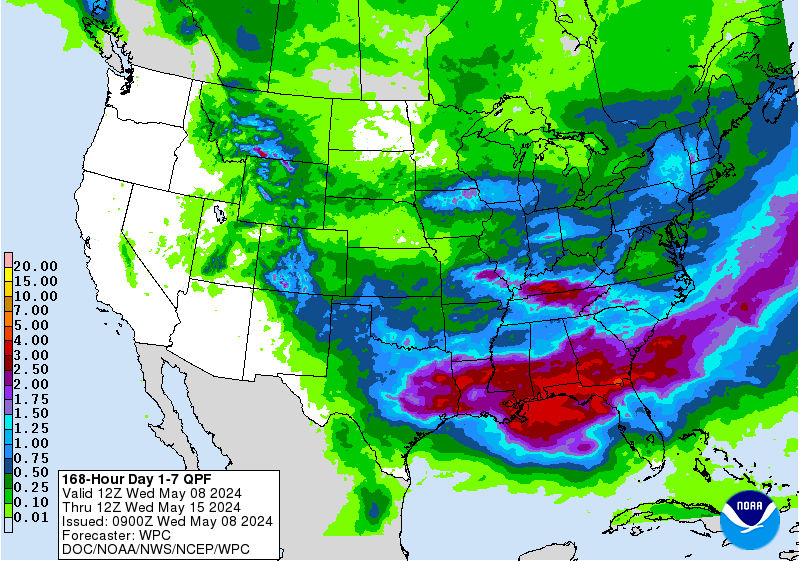Author: Natalie Hoidal, UMN Extension educator, local foods and vegetable crops
If you're seeing
interesting things in your fields, need help identifying problems, or
just want to share photos, we'd love to hear from you! Growers can reach
out directly to me any time at hoida016@umn.edu, and you can submit questions and diagnostic help here.
Vegetable weather report
 |
| 7 day precipitation forecast from weather.gov |
Soil temperatures from MDA stations, data collected to 6’’ depth
|
Station location |
Nearest major town |
Coldest soil temperature in the last 7 days (approx.) |
Temperature on May 18, 2020 |
|
Blue Earth |
Albert Lea (Iowa border) |
50.5 º F |
55.5 º F |
|
Russel |
Marshall |
54 º F |
67 º F |
|
Henderson |
St. Peter / Belle Plaine |
52 º F |
68 º F |
|
Campbell |
Wahpeton / Elbow Lake |
52 º F |
63º F |
Soil temperatures from ND-managed stations in MN are collected to a depth of 4"
|
Station location |
Nearest major town |
Average turf soil temp on May 19 (4’’) |
|
Sabin |
Fargo / Moorhead |
63º F |
|
Mavie |
Thief River Falls |
55 º F |
|
Fox |
Roseau (Canada border) |
61 º F |
Crop updates
- Cole crops: Most
farmers have planted / transplanted their first couple of Brassica
successions at this point. We had a glitch in our degree day models this week, so we'll have an update next week. But for now, we can assume that cabbage maggots will be flying if not now, very soon, in southern Minnesota, and seedcorn maggots are active. Put out your row cover if that's a strategy you use, or plan to manage these insects in other ways (for insecticide recommendations see the Midwest Vegetable Production Guide).
- Sweet corn: Soil temperatures are reaching 60-65 degrees throughout much of the state, which translates to ideal sweet corn planting / transplanting temperatures.
- Lettuce: Many farmers are making their last cuts of greenhouse lettuce this week to make way for tomatoes, cucumbers, etc. Meanwhile, the very first successions of outdoor lettuce are maturing this week.
- Carrots and beets: Continue to provide irrigation through germination, especially if your soils are prone to crusting. Hot weather after rainfall can lead to crusting in clay soils, which can prevent germination and sever recently germinated seedlings. Carrots and beets, being very small-seeded crops, are quite susceptible.
- Onions: Onions seem to be doing well. Onion seedlings can be effected by seedcorn maggot, so keep an eye out for damage.
- Garlic: Garlic is beginning to enter the bulbing stage, at which point it becomes very susceptible to dry soil conditions. Make sure that your soil is not dropping below 50% water holding capacity (more about irrigation monitoring below). At this point, avoid applying more nitrogen.
- Asparagus: Asparagus harvest is well under way.
- Potatoes: are starting to emerge. I've now received two reports of potato beetle emergence.
 |
| Potato beetles have now been spotted on two farms in Minnesota. Photo: Ward Upham, Kansas State University, Bugwood.org |
- Peas are establishing well with no reported problems so far.
- Cucurbits: Cucumbers and melons are being transplanted, and growers are starting to direct seed squash and pumpkins. We've seen some cold damage in pumpkins, which can look like yellowing of the leaf margins (this could also be a nutrient issue, but symptoms are showing up very suddenly after transplanting). Keep in mind that cucurbits are extremely sensitive to root disturbance, so handle your transplants carefully. If you have two seedlings in a cell, it is usually not worth trying to break them up.
- Tomatoes: Tomatoes
are again all over the place, ranging from the flowering stage in tunnels, to just being transplanted in both tunnels and the field. We've seen a few reports of diseased tomatoes already, so make sure you're scouting as you transplant, as well as regularly after that. We've also seen some potential cold damage symptoms in tomatoes that can look a bit like a nutrient deficiency (yellowing along the leaf margins).
Problems in the field and things to anticipate this week
Irrigation water adjustments
Herbicide drift
 |
| Herbicide damage symptoms often present as puckered or curled leaves. Photo: Jed Colquhoun, University of Wisconsin, Bugwood.org |
Comments
Post a Comment